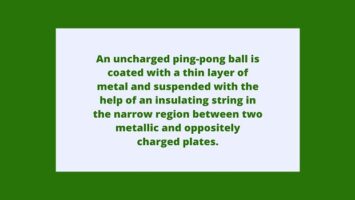What is Thermal Conductivity?
Consider a metallic bar of length L and uniform cross-section A with its two ends maintained at different temperatures. This can be done, for example, by putting the ends in thermal contact with large reservoirs at temperatures, say, TC and TD , respectively as shown in the figure. Let us assume the ideal condition that the sides of the bar are fully insulated so that no heat is exchanged between the sides and the surroundings.

After some time, a steady state is reached; the bar’s temperature decreases uniformly with distance from TC to TD ; (TC >TD ). The reservoir at C supplies heat at a constant rate, which transfers through the bar and is given out at the same rate to the reservoir at D. It is found experimentally that in this steady state, the rate of flow of heat (or heat current) H is proportional to the temperature difference (TC – TD ) and the area of cross-section A and is inversely proportional to the length L:

The constant of proportionality K is called the thermal conductivity of the material. The greater the value of K for a material, the more rapidly will it conduct heat. The SI unit of K is J s–1 m–1 K–1 or W m–1 K–1.
Thermal Conductivity in Daily Life:
(1) Snow is a better heat insulator than ice. When the temperature of the atmosphere falls below 0°C, ice crystals are directly formed due to the freezing of water vapor present in the air. These crystals often coalesce and take a cotton-like shape to form what is known as snow. Thus snow contains air pockets. As air is a bad conductor of heat and convection currents cannot be formed in the air pockets of snow, it behaves as a very good heat insulator.
(2) In winter, iron feels colder than wood although both are at the same temperature. It is due to the fact that iron is a good conductor of heat. During winter our body is at a higher temperature than a piece of iron or wood kept outside in the open air. When we touch such a piece of iron, heat from our body gets conducted rapidly from one portion of the iron piece to another giving us a cold feeling.
(3) The bulb of thermometers is usually cylindrical. Herat conduction is directly proportional to the cross-sectional area presented for the heat flow. If we consider a spherical bulb and a cylindrical bulb of the same volume, then the cylindrical bulb would have a larger surface area. Hence heat would be conducted more rapidly in a thermometer with a cylindrical bulb. The response of such a thermometer is quicker than a thermometer with a spherical bulb.
(4) During summer evenings, the temperature of the inner walls of a room is usually higher than the outside temperature. On a summer day, the outside temperature is quite high due to the heat of the sun. Walls being bad conductors of heat do not allow much heat to enter inside the room. So during day time, the temperature of the inner walls is usually lower than that of the outside. However, in the evening the outside temperature falls rapidly. Since walls are bad conductors, heat from the inside of the room cannot go out rapidly. Hence the temperature of the inner walls of a room becomes higher than that of the outside in the evening.
(5) Ice is kept wrapped with a blanket or sawdust. The air present in the interspaces does not allow heat to flow from outside to the ice, hence, ice does not melt quickly. The air is a bad conductor of heat, and as air is trapped in small pockets even convection currents are not possible.
(6) Thermal conductivity of air is less than that of felt yet felt is a better heat insulator. The thermal conductivity of air is low, but open air is capable of transferring a considerable amount of heat by the process of convection currents. Hence it does not work as a good insulator. In a felt or blanket fine holes are present. Although these holes also contain air but this air is not free to give rise to the convection currents.









Comments (No)